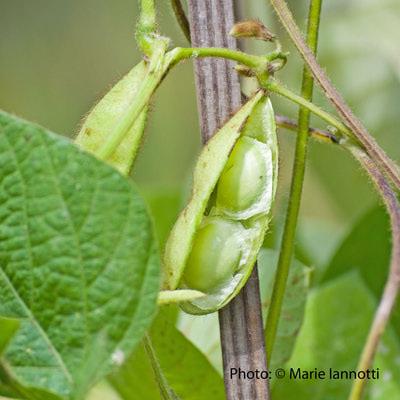How to Grow Soybeans Soybean membranes keep the beans tightly connected to the pod. You can also see the fuzzy hairs on the outside of the pods. Overview and Description Call them soybeans, soya or edamame, these legumes are packed with protein, fiber and a host of other nutrients and they are just as easy to grow as common green beans. The Chinese call them mao dau, 'hairy bean', because of their fuzzy pods. These pods can be difficult to open when fresh, but cooking makes them easy to pop. They can be an addictive snack, when boiled in salted water or roasted. I also like to puree them for pesto or hummus. And they freeze quite well, so plant a lot. [Note: Do not eat Soybeans raw. They contain high levels of protease inhibitors, an enzyme we need to digest food, and can be toxic.] Foliage: Both the stems and leaves are covered in fuzzy hairs. Plants branch heavily. Flowers/Fruit: The profuse, attractive, white flowers have a tinge of lavender. Seeds can be cream, beige, green, black or bi-colored. Botanical Name Glycine max Common Names Soybeans, Soya, Edamame (ed-a-ma-may) Hardiness Zone Soybeans are grown as annuals, but keep your hardiness zone in mind when selecting a variety to grow. Some require a long growing season with temperatures steadily above 70 F. Most of the newer varieties are being bred to mature faster and handle cooler temperatures. Sun Exposure Soybeans need full sun, for maximum yields. They can handle partial shade, particularly in the afternoon, but flowering may be diminished. Mature Size Height will depend on the variety you are growing, but should be somewhere between 18 - 36 in. The pods grow in clusters of 3 - 5 and get about 2 - 4 in. long. Days to Harvest Most soy bean varieties will be ready to harvest in 75 - 85 days. The pods should be a bright green and feel plump. Each pod will have 2 - 3 beans inside. If you are growing them for dried beans, you can let the pods dry on the plants or pull the whole plant out and let the pods dry - on the plant - in a dry spot indoors. Suggested Varieties Commercial soybeans get a lot of bad press because of the proliferation of GMO varieties. Take heart, there are plenty of non-GMO soybeans to grow at home. I've read that there are over 10,000 soybean cultivars, but I've only seen a handful offered as seed. As they become more popular, there should become more available. Here are some good ones that you should be able to find in seed catalogs. 'Agate’ - Popular New Mexico variety. Olive green with a brown saddle. (65-70 days) 'Butterbean' - Prolific, sweet and bright green. (85-90 days) 'Envy' - A good choice for sort seasons. Pale green seeds. (75 - 80 days) ‘Fiskeby’ - A Swedish-bred variety that is good for cooler climates. (75 - 80 days) 'Shirofumi' - Tall, vining plants and extremely productive. Often mentioned as a substitute for lima beans. ( 80-90 days.) Growing Tips Soil: Soybeans like a relatively rich soil with plenty of organic matter. As legumes, they will fix their own nitrogen and established plants are very drought tolerant, but it helps to start them off with good soil. They are not terribly fussy about soil pH, but a neutral to slightly acidic soil (6.0 - 6.8) is optimal. Planting: Direct sow the seed a couple of weeks after your last frost date. As with most bean seeds, it is best to wait until the soil has warmed and dried before planting, or the seeds may rot. In wet springs, using an inoculant will help germination. Plant seed about 1 - 2 in. deep, spaced 3 - 4 in. apart, in rows 24 - 30 in. apart. Most soybeans have about an 80% germination rate, so over plant slightly. Then thin to about 6 - 8 in., so that plants are not overlapping. Seed should germinate within 2 weeks. Growing Soybeans in Containers: Because soybean plants are stocky and most varieties don't grow very tall, they make a good option for containers. Use a container that is at least 12 in. deep, the bigger the better. Direct sow seeds outdoors, after all danger of frost, or get a head start indoors and move the pot out once the weather warms. You should be able to fit 3 plants in a 12 in. container, but start by planting 4 - 5 seeds and thinning to the 3 healthiest plants. Once they are up, care for them the same as you would for plants in the ground, except that your container soybeans will probably need more frequent watering and some fertilizer. Maintenance Except for a handful of tall, vining varieties, soybean plants do not need a support to grow up. The most important maintenance will be keeping the plants watered on a regular basis. Although they are drought tolerant, you will get more flowers and pods if the plants are not stressed. Mulching will help to keep the soil moist and cool. If you have good soil, do not apply any supplemental fertilizer. Too much nitrogen in the soil will diminish flowering and pod set. If your plants flower but don't form pods, you can give the plants a bit of kelp fertilizer. Pests and Problems Soybeans can susceptible to the same problems as other types of beans. The worst problem is probably bean beetles, but also aphids, leaf spot and rust. Healthy plants that get regular water and good air circulation tend to be less susceptible. Avoid handling the plants when the leaves are wet, to prevent spreading fugal spores.


